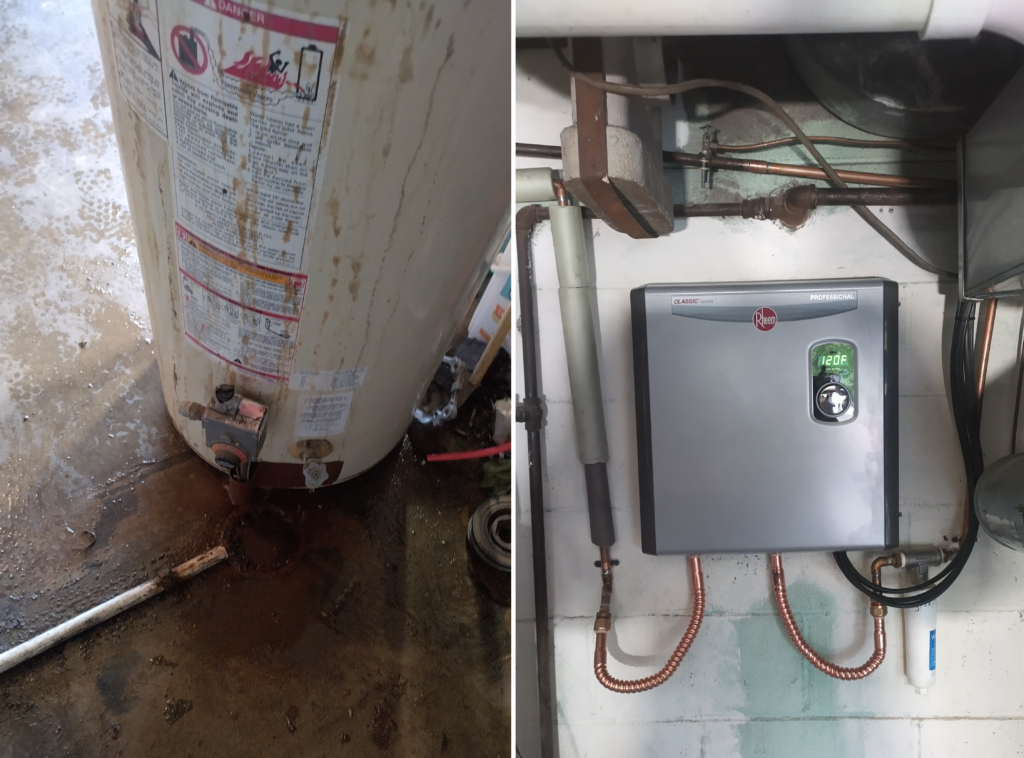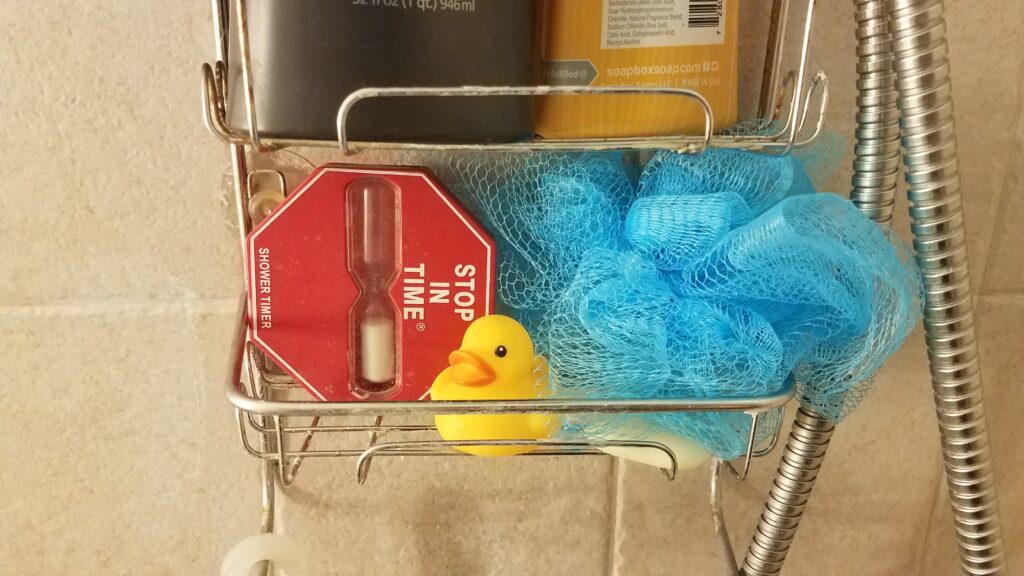As of last month, we officially have a new hot water heater. Long-time readers of this blog will know that our tank water heater, which was approximately 12 years old in 2007 when Christian bought the house, was on its last legs. (Just for reference, when I was working in energy efficiency, the average lifespan for this appliance was ballparked at 15 years.) Unsurprisingly, ours was more than ready to depart this world last Christmas, when it was actively leaking onto our garage floor. Fortunately, it held on long enough for us to do some research into replacement options and actually do the work necessary to prepare for a pretty significant switch. [1]
Making A Choice
There were several reasons I ultimately recommended a tankless electric water heater to replace our gas-powered tank model. Given trends for home electrification across the country, we would be in the early majority of a move to decarbonize the residential sector by switching our appliances from gas to electric. [2] Of course, our electricity supply would also need to come from renewable sources in order to achieve the goal of decarbonization, but getting a third-party electricity supplier that supports wind and solar energy helped us clear that bar. [3]

Photo credit: Christian Korey
I conducted calculations based on equipment purchase, installation, and maintenance costs, outlooks for gas and electric price trends, and how much energy we would be using to run the appliance over the next 20 years (the estimated lifetime of the electric unit). Unfortunately, the net present value calculations of the gas vs. electric model scenarios varied wildly based on the assumptions we had to make for each variable. Sometimes gas was ahead, sometimes it was electric, and sometimes it was a wash.
But ultimately, I wanted to support the trend of moving toward electrification and away from fossil fuels, and as long as the price differential wasn’t prohibitive (which it wasn’t for us in any of the scenarios I ran), I recommended going electric. There are other electric appliance options for this situation, including tank water heaters and heat pump water heaters, but based on the fact that the water heater would still be located in our uninsulated and unconditioned garage, it made less sense to go the storage tank or heat pump route since the unit would be working against lower ambient air temperatures in cold weather.
Taking the Plunge
I found a unit I liked that had excellent reviews online (notwithstanding some amusing 1-star reviews from people who clearly didn’t read the product specifications), and Christian decided to upgrade to the next model up, which would support more heated water volume at a given time, in case we ever sold our home to a family that would need to run multiple appliances, showers, and/or sinks at once. [4] The increase in cost was not too much more for a significant increase in capacity, so we agreed that it made sense, if excessive for us. But in order to supply the necessary power to the unit, we had to have our electric service upgraded, which happened in March, by a professional. [5]

Photo credit: Christian Korey
With the electrical component covered, it was time for Christian to hook up the tank, which he did himself over Memorial Day weekend. For the record, he had never done any work like that before but considered it to be a manageable task for anyone who has a basic level of mechanical ability and the confidence to learn new skills, largely via YouTube tutorials. (That being said, you may not want to practice on an expensive piece of equipment.) There was some electrical wiring involved to attach the unit to the new wires installed by the electrician, there was some soldering of pipes to hook it up to our water line, and there was some use of a hammer drill to mount the unit itself to the wall in our garage. But ultimately, it is possible to install an electric water heater on your own, unlike installing a gas water heater, which absolutely needs to be installed and checked by a professional because of combustion and carbon monoxide risks.
Once Christian turned off the gas and water supplies, it was time to disconnect the tank and drain it before it could be moved outside. Unfortunately that took about two days since there was so much sediment in the bottom of the tank. During this time, we had no hot water, which was exciting, since I spent that weekend doing yard work and would have appreciated a shower that was more than about 55 degrees. Once the tank was out of the way, Christian mounted the unit to the wall and connected copper pipes to the inlet and outlet points, including a water softener on the inlet side. Finally, all that was left to do was connect red, black, and ground in each of the three new wires running to the unit and replace the cover. It looked very good, but the question remained: how well would it work?
Rave Reviews
Christian got the privilege of taking the first shower – and rightfully so after all the hard work he put in over those two days. His review of the maiden voyage was positive, and I (covered in sweat, dirt, and sunblock) was right behind him. The hot water was available almost instantly – just the amount of time it took from the water to travel from the heater to the showerhead. No doubt it will take a little longer in winter when the pipes are cold to start with, but I also know how dangerously tempting it will be to stay in indefinitely when I don’t have to worry about the prospect of hot water running out.

What I didn’t expect was how clean the water smelled as it came out of the showerhead, probably a result of 1) ditching the sediment-filled tank and 2) installing the water softener, which will help prevent the buildup of scale in our new high-tech piece of equipment. And having softer water has had a wonderful effect on my hair. I’m still not using shampoo (going on almost five years now), [7] and I don’t even remember the last time I used conditioner, so I was accustomed to a certain level of frizz on the top of my head, despite frequent brushing to distribute oils from my scalp along the length of my lengthy hair. But over the past month my hair has become smooth and soft to a level I never thought I could achieve without going back to styling products.
As I said before, we will see what happens with our new tankless electric water heater in the coming months, particularly when we hit cold weather. Just in the past few weeks, we’ve already had a dip in our gas usage (but haven’t gotten the electricity bill yet). Of course we have historic records of those bills so I will be able to do an analysis in a year’s time or two. But for now, I’m thrilled to say that my hot showers are even more enjoyable, knowing that they’re being brought to me thanks to renewable electricity.
~
Have you gone electric with your hot water heater? What model did you choose and why?
I’d love to hear your experiences below.
Thanks for reading!
[1] https://radicalmoderate.online/tankless-water-heater/
[2] https://radicalmoderate.online/beneficial-electrification/
[3] https://radicalmoderate.online/renewable-energy-and-energy-independence-part-2/
[4] https://www.rheem.com/products/residential/water-heating/tankless/tankless_electric/
[5] https://radicalmoderate.online/electrical-service-upgrade/
[6] https://www.youtube.com/watch?v=7BX3cSNfzlY
[7] https://radicalmoderate.online/to-shampoo-or-not-to-shampoo/
0 Comments